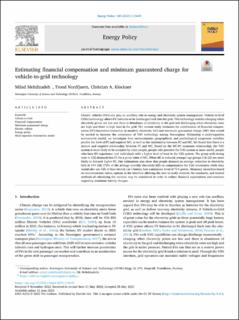| dc.contributor.author | Mehdizadeh, Milad | |
| dc.contributor.author | Nordfjærn, Trond | |
| dc.contributor.author | Klöckner, Christian Andreas Nikolaus | |
| dc.date.accessioned | 2023-11-20T07:33:53Z | |
| dc.date.available | 2023-11-20T07:33:53Z | |
| dc.date.created | 2023-05-25T17:36:09Z | |
| dc.date.issued | 2023 | |
| dc.identifier.citation | Energy Policy. 2023, 180 . | en_US |
| dc.identifier.issn | 0301-4215 | |
| dc.identifier.uri | https://hdl.handle.net/11250/3103432 | |
| dc.description.abstract | Electric vehicles (EVs) can play an ancillary role in energy and electricity system management. Vehicle-to-Grid (V2G) technology allows EV batteries to be discharged back into the grid. This technology enables charging when electricity prices are low and there is abundance of electricity in the grid and discharging when electricity costs are high and there is high load in the grid. The current study estimates the combination of financial compensation (FC) incentives (reduction in monthly electricity bill) and minimum guaranteed charge (MC) that would be needed to increase the acceptance of V2G technology among Norwegians. Estimating a multi-equation econometric model, we investigate how socioeconomic, geographical, and psychological exogenous variables predict the level of FC and required MC, as well as the relationship between FC and MC. We found that there is a mutual and negative relationship between FC and MC. Based on the MC-FC economic relationship, the V2G system is more likely to be accepted by older people, people who perceive the V2G system as more useful, people who have EV experience, and individuals with a higher level of trust in the V2G system. The group with strong trust in V2G demands less FC for a given value of MC. When MC is reduced, younger age groups (18–22) are more likely to demand higher FC. Our estimations also show that people demand an average reduction in electricity bills of 144 USD (72% of the average monthly electricity bill) as compensation for V2G investment while they would also use V2G if their electric car’s battery had a minimum level of 71% power. Monetary incentives based on socioeconomic status, options in the interface allowing the user to easily override the standards, and trusted methods of calculating the revenue may be considered in order to reduce financial expectations and concerns regarding minimum battery charges. | en_US |
| dc.language.iso | eng | en_US |
| dc.publisher | Elsevier B. V. | en_US |
| dc.rights | Navngivelse 4.0 Internasjonal | * |
| dc.rights.uri | http://creativecommons.org/licenses/by/4.0/deed.no | * |
| dc.title | Estimating financial compensation and minimum guaranteed charge for vehicle-to-grid technology | en_US |
| dc.title.alternative | Estimating financial compensation and minimum guaranteed charge for vehicle-to-grid technology | en_US |
| dc.type | Peer reviewed | en_US |
| dc.type | Journal article | en_US |
| dc.description.version | publishedVersion | en_US |
| dc.source.volume | 180 | en_US |
| dc.source.journal | Energy Policy | en_US |
| dc.identifier.doi | 10.1016/j.enpol.2023.113649 | |
| dc.identifier.cristin | 2149385 | |
| dc.relation.project | Norges teknisk-naturvitenskapelige universitet: 296205 | en_US |
| dc.source.articlenumber | 113649 | en_US |
| cristin.ispublished | true | |
| cristin.fulltext | original | |
| cristin.qualitycode | 1 | |

